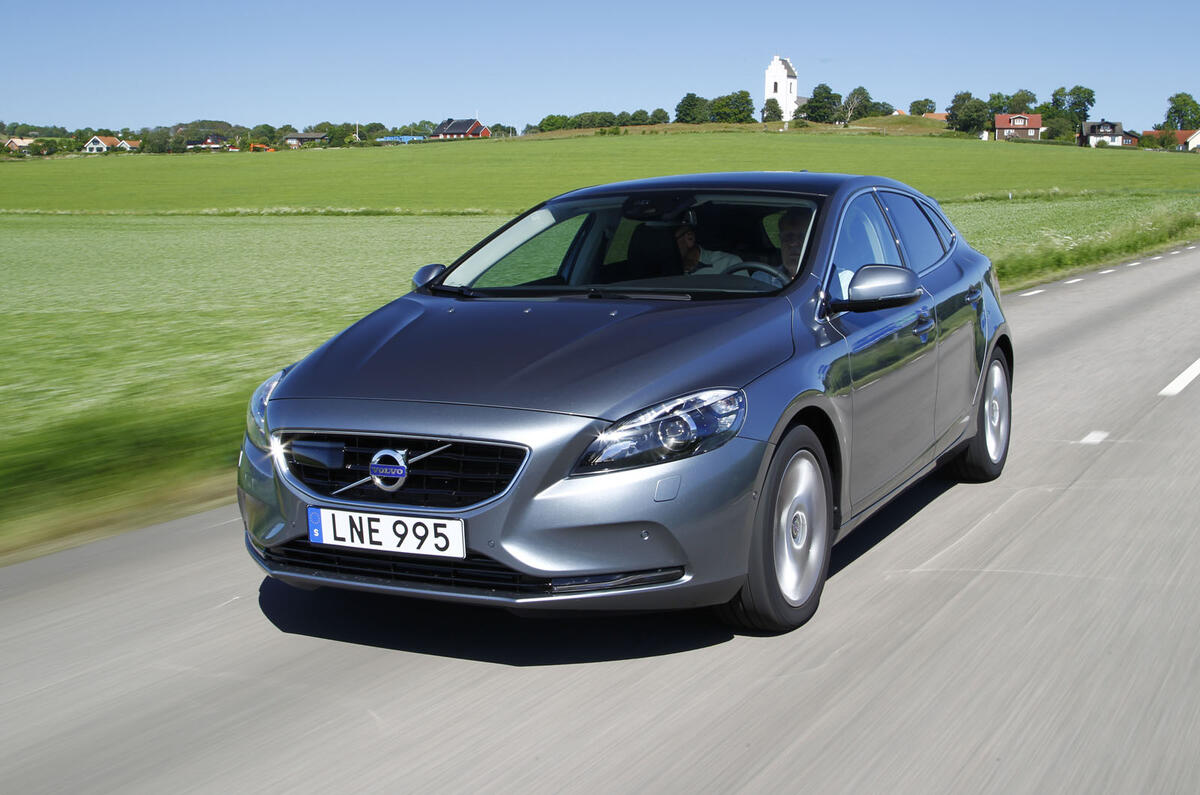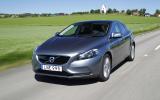What is it?
Volvo is unveiling the first version of its best-selling V40 hatch to be powered by one its all-new Drive-E modular engine family – the 190bhp D4 diesel – and we’ve been driving it in Sweden.
The car, impressive for its performance, is even more outstanding for its clean air statistics: it emits just 99g/km of CO2, a class-beating output more akin to a 1.6-litre diesel producing 70-80bhp less.
The Drive-E D4 goes on sale this month alongside a high-performance petrol turbo version, the 245bhp Drive-E T5. The pair will lead a lightly revised 2015 V40 line-up that comes minor frontal changes, an optional glass sunroof plus upgrades to its navigation and infotainment systems.
Eventually Volvo will offer eight petrol and diesel versions of its 2.0-litre engine family across its model line-up, stretching in power output from 120bhp to 230bhp for oil burners, and 140bhp to over 300bhp for the petrol engines.
In Volvo's brave new world, all new models for the near to mid-term will be powered by four-cylinder engines – although the company's new powertrain chief, Michael Fleiss, does not rule out the future development of some 1.5-litre three-cylinder models that use the same engine architecture.

















Join the debate
Add your comment
CAR MANUFACTURERS HAVE LOST SIGHT OF THE FOREST !
I am referring to their attempts to increase performance and reduce fuel consumption, emissions and operating costs. But let us first examine typical Energy Losses in a car
Only about 15% of the energy from the fuel you put in your tank gets used to move your car down the road or run useful accessories, such as air conditioning. The rest of the energy is lost to engine and drivel ine inefficiencies and idling. So, the potential to improve fuel efficiency is enormous.
Engine Losses - 60%
In petrol-powered vehicles, about 60% percent of the fuel's energy is lost in the internal combustion engine (ICE). ICE engines are very inefficient at converting the fuel's chemical energy to mechanical energy, losing energy to engine friction, pumping air into and out of the engine, and wasted heat.
Advanced engine technologies such as variable valve timing and lift, turbo charging, direct fuel injection, and cylinder deactivation attempt to reduce these losses.
Still, diesels are about 30% more efficient than petrol engines.
Idling Losses - 17 %
In urban driving, significant energy is lost to idling at stop lights or in traffic. Technologies such as integrated starter/generator systems help reduce these losses by automatically turning the engine off when the vehicle comes to a stop and restarting it instantaneously when the accelerator is pressed.
Drive line Losses - 7% percent
Energy is lost in the transmission and other parts of the drive line. Automated manual and continuously variable transmissions, are attempting to reduce these losses.
Overcoming Inertia; Braking Losses - 6%
To move forward, a car's drive train must provide enough energy to overcome the vehicle's inertia, which is directly related to its weight. The less a car weighs, the less energy it takes to move it. Weight can be reduced. Transmissions contribute significantly to a car’s weight.
In addition, any time you use your brakes, energy initially used to overcome inertia is lost.
Rolling Resistance - 4.5%
Aerodynamic Drag - 3%
Accessories - 2.5%
Source: www.fueleconomy.gov/feg/atv.shtml
Loss reduction is possible in all areas. Here we are concerned with the first four which together represent about 90% of the total. Let us examine them.
Engines
Engines are becoming increasingly complex, have more moving parts (turbos, extra valves and cams, variable timing, etc). Compared to the engines of yesterday, they also produce their turbo related power at higher RPM. All these increase internal friction losses. Ironic, since losses eat into the primary objective of reduced fuel consumption through turbo charging, complexity and downsizing. Stronger forces applied to the mechanical parts mean more losses. In a conventional engine, an increase in specific power and torque leads to bigger moving parts that generate higher friction losses. High specific power and torque in a modern state of the art engine leads to the same power/torque gains, but if losses are not contained any benefits are lost. What remains is the extra cost, complexity and even weight.
The relationship between mechanical load and friction losses is well known. To reduce fuel consumption, a modern engine is subjected to high in-cylinder pressures for high specific torque and power. This way complex modern engines attempt to be efficient enough. Nevertheless, if it is not possible to avoid rising losses, the energy efficiency gains can easily disappear.
Modern downsized engines have higher friction than ordinary engines and yet they are attempting to provide better efficiency during standard use. If we double frictional losses while doubling the engine’s power per liter, the total friction losses of the driving cycle remain identical. It’s easy to understand that the aim needs to be to increase the engine’s specific power faster than its specific friction. Downsizing needs to be accompanied by a reduction in energy losses due to friction and also by a reduction in pumping losses during standard use.
But, an engine’s specific power is not the only factor weighing on friction performance; its specific torque at low speeds (Nm/L) also plays an important role. On one hand, increasing torque at low speeds increases the size of the engine’s moving parts, which increases its friction losses. On the other hand, high torque at low speeds reduces the engine’s operating speed (downspeeding), which reduces friction and pumping losses. It all boils down to finding the right balance. Turbo charging helps but even small turbos need exhaust gases running at certain temperature and speed in order to be of any significance. If the standard engine RPM operating range is from just above 800 RPM to 3000 RPM, then by the time even a small turbocharger comes into real effect, an appreciable % of the RPM range and perhaps the most meaningful in urban conditions, has been used. Furthermore, turbo charging interferes with the exhaust system and the way gases are extracted from an engine.
Downspeeding can potentially be very effective in reducing friction losses, as an engine’s frictional losses increase exponentially to engine speed. Engine downspeeding provides several advantages: Frictional losses are much lower at lower rpm and pumping losses are also reduced when the engine runs at lower speed. Load has a small influence on the level of engine friction, much less than engine speed does.
Modern engines have increased friction losses which render thermodynamic gains unworthy as they are lost to mechanical friction. Car manufacturer’s have fallen into this trap. To bear high loads, the engine’s moving parts are bigger and more complex, which increases the engine’s losses. Choices are made between conflicting strategies. Loading the engine, to take advantage of downsizing, results in upsizing the moving parts accordingly. The gains generated by reducing cubic capacity are reduced or even eliminated by the additional friction. Downsized high specific output engines are also more likely than conventional larger capacity engines to venture beyond the lower speed range simply because this is where most of their turbocharged power can be found. This wipes out the main target of reduced fuel consumption (“the forest”) made through downsizing.
Worthwhile solutions do not loose sight of FMEP/(KW/L ratio) which in a conventional engine is low. No surprise then that modern engine gains are mostly lost to friction. But this still remains “tree sighting”. We tend to forget the added complexity, stress, noise, cost, weight and longer term durability.
Transmission Losses 7%
This is not something to ignore. Adding to cost is the weight of transmissions, which contributes substantially to a car’s overall weight and therefore to inertia and braking losses which in total account for a further 7% of losses. Transmissions add weight, cost, complexity, noise and maintenance costs and manual transmissions in particular not only make driving in today’s driving environments more stressful but also increase fuel consumption and emissions since in real life almost no one changes gears at the ideal time.
Accessories 2.5%
Starter motor, alternator, flywheel, brake size, even the way the air condition compressor is driven, waste energy whilst adding excess weight, cost and complexity to a car.
SOLUTION
There is a way to address all the above issues simultaneously, in an effective way that improves fuel consumption and reduces emissions in the real world (not only during theoretical government tests) which also costs less, weighs less, is much simpler to construct and maintain and it is based on existing, widely available technologies, makes less noise and vibration, simplifies car operation, makes cars less complex, more reliable and durable in the longer run and reduces maintenance costs substantially.
High price!
difference being you will
A clearly very expensive engine tech . . .